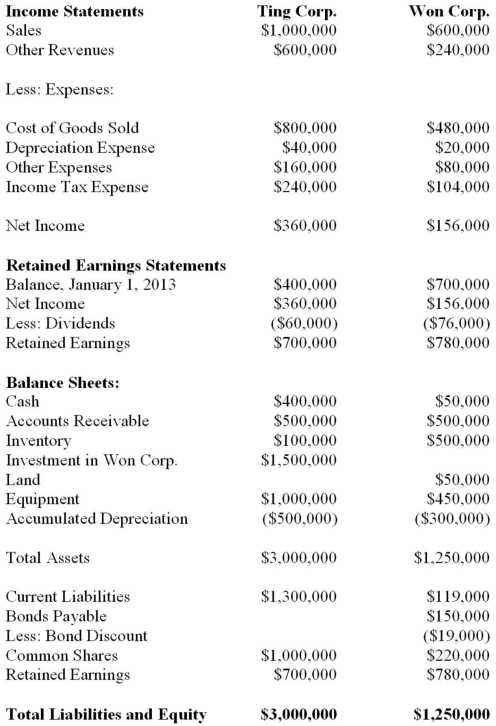Ting Corp. owns 75% of Won Corp. and uses the Cost Method to account for its Investment, chapters) for the Year ended December 31, 2013 are shown below:  Other Information: ▪Won sold a tract of land to Ting at a profit of $20,000 during 2013. This land is still the property of Ting Corp.
Other Information: ▪Won sold a tract of land to Ting at a profit of $20,000 during 2013. This land is still the property of Ting Corp.
▪On January 1, 2013, Won sold equipment to Ting at a price that was $20,000 lower than its book value. The equipment had a remaining useful life of 5 years from that date.
▪On January 1, 2013, Won's inventories contained items purchased from Ting for $120,000. This entire inventory was sold to outsiders during the year. Also during 2013, Won sold inventory to Ting for $30,000. Half this inventory is still in Ting's warehouse at year end. All sales are priced at a 20% mark-up above cost, regardless of whether the sales are internal or external.
▪Won's Retained Earnings on the date of acquisition amounted to $700,000. There have been no changes to the company's common shares account.
▪Won's book values did not differ materially from its fair values on the date of acquisition with the following exceptions:
▪Inventory had a fair value that was $50,000 higher than its book value.
▪A patent (which had not previously been accounted for) was identified on the acquisition date with an estimated fair value of $20,000. The patent had an estimated useful life of 5 years.
▪There was a goodwill impairment loss of $10,000 during 2013.
▪Both companies are subject to an effective tax rate of 40%.
▪Both companies use straight line amortization exclusively.
▪On January 1, 2013, Ting acquired half of Won's bonds for $60,000.
▪The bonds carry a coupon rate of 10% and mature on January 1, 2033. The initial bond issue took place on January 1, 2013. The total discount on the issue date of the bonds was $20,000.
▪Gains and losses from intercompany bond holdings are to be allocated to the two companies when consolidated statements are prepared. The amount of goodwill arising from this business combination is:
Definitions:
Price Discrimination
A method of setting prices where a provider charges different amounts for the same or almost the same items or services to different customers or in various locations.
Monopoly Practices
Business actions by a monopolist aiming to acquire, enhance, or maintain its monopoly power, often to the detriment of consumers and competition.
Demand
The willingness and ability of consumers to purchase a quantity of a good or service at various prices during a specified period.
Price Discrimination
A pricing strategy where a seller charges different prices for the same product or service to different customers, based on factors like willingness to pay, customer location, or purchase volume.
Q1: Find Corp and has elected to use
Q3: The sum of the discount factors applicable
Q6: If the cost of goods sold for
Q13: Using the direct method, the amount of
Q14: According to IAS 29, the term "hyper-inflationary"
Q14: Telecom Inc has decided to purchase the
Q19: Which of the following entities would most
Q33: The Gross Margin at Split-Off method should
Q39: The maximum amortization period specified by Section
Q64: Which of the following is not an